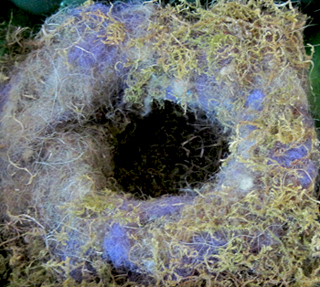What’s in a nest? It’s astonishing just how much can be achieved with just a beak and a variety of building materials.
 The skill and ingenuity of birds in building new nests every year should not be underestimated. They source their building materials carefully, and construct the nest according to the breeding ecology of their species. Clearly, size matters, and the larger the species, often the bulkier the building materials. But it’s the nests of small passerines that are perhaps the most fascinating for their complexity of technique and specific use of moss, grasses, bark, lichens, and even spiders webs for gluing the construction together.
The skill and ingenuity of birds in building new nests every year should not be underestimated. They source their building materials carefully, and construct the nest according to the breeding ecology of their species. Clearly, size matters, and the larger the species, often the bulkier the building materials. But it’s the nests of small passerines that are perhaps the most fascinating for their complexity of technique and specific use of moss, grasses, bark, lichens, and even spiders webs for gluing the construction together.
Hole nesters, such as Great tit and Blue tit may use a lot of moss as a nest base, sometimes with honeysuckle bark and grass, before forming the nest cup of wool, hair, fur, and feathers. Birds nesting in hedgerows use the network of fine twigs to weave a strong basket of grasses and fine bark strips, inside which they add a lining of hair, wool or just very fine plant material. Feathers are often highly prized as nest coverings and linings; some individuals will collect a great many feathers in order to hide the clutch of eggs from potential marauders.
Here are just a few examples of what’s been incorporated into a nest site near you. Just for fun, see if you can guess who built what. Choose from Blackbird, Cirl bunting, Great tit, Sparrow, Wren, and Blue tit. Answers at the bottom of the page.
Cirl Bunting Reintroduction Project News
Celebrations were in order on June 24th, on the occasion of the birthday of our oldest male cirl on the Project when attained the grand age of 5 years. We know this, because he is one of the remaining few ringed birds originally taken as nestlings from Devon in 2010 and 2011. This particular male was collected from an early nest at Greenway, at one time Agatha Christie’s estate near Galmpton on the River Dart in Devon. He was just 6 days out of his egg, and was ringed with the combination of Yellow/Red on his right leg, Red/metal on his left. He is currently breeding with an unringed female near Portscatho.
Another important milestone was reached on June 25th, when the number of breeding pairs reached 45, exceeding the previous highest total of 44 in 2012. Whilst 2012 was a disastrous year for breeding because of the endless wet weather, this year of generally good weather should prove as productive as 2014, boosting the population still further. The next milestone we would like to achieve is 50 pairs by September. On the 26th June, pair 46 was confirmed, so we have just four more pairs to discover by then.
Wildlife news in June
- The Cuckoo was still being heard around Lanhay/Polingey. It was first heard in early May.
- AK Wildlife Cruises have been reporting some exciting wildlife sightings out on the water recently, including the first Oceanic Sunfish and Minke Whale of the season. In the water, Barrel and Compass jellyfish are appearing on the surface in good numbers, some of them being washed ashore on our beaches.
- Keen birders should also be able to catch sight of Storm petrels, occasional Puffin, and Great skuas harassing other avian species as they hunt them down. Manx shearwaters should be visible as they fly low in large feeding flocks offshore. Guillemots and Razorbills should be showing well at sites such as Gull Rock.
- The two ringed Choughs were still hanging out below Nare Head in June. They attempted to construct a nest for the first time this year (they are now two years old), but then did not attempt to breed. We still do not know what sex either of these siblings is. However, they seem to have settled in the Roseland, so hopefully they might breed in the future.
Science news from the British Trust for Ornithology
More than 60{c8c3b3d140ed11cb7662417ff7b2dc686ffa9c2daf0848ac14f76e68f36d0c20} of countryside is farmland. Studies show beyond doubt that agri-environment schemes have helped to slow the decline of many farmland bird species. However, decline is still the depressing status descriptor for Skylark (-63{c8c3b3d140ed11cb7662417ff7b2dc686ffa9c2daf0848ac14f76e68f36d0c20}), Yellowhammer (-60{c8c3b3d140ed11cb7662417ff7b2dc686ffa9c2daf0848ac14f76e68f36d0c20}), Lapwing (-30{c8c3b3d140ed11cb7662417ff7b2dc686ffa9c2daf0848ac14f76e68f36d0c20}) and significant others, according to the latest BTO research. The decline of such keystone species is no casual loss, but an indicator of the diversity and health of our landscape and environment. Imagine a Roseland in summer, once characterised by Skylark song over every field but now completely silent. Already, the Yellowhammer’s song is rarely heard here.
The BTO now plan to study in depth how birds are adapting (or not) to the latest practices in land management, as well as to the dynamically evolving environmental factors of climate, interspecific competition, parasites, disease and predation. The knock-on effects of their decline could affect even ourselves in the future.
Find out more about this important work by downloading the BTO’s Farmland Bird Appeal brochure. (PDF).
ANSWERS TO NEST QUIZ:
- Wren
- Blackbird
- Cirl bunting
- Great tit
- Sparrow
- Blue tit
References
All Photography by Sarah E Vandome, unless otherwise indicated.
Enjoy more Roseland wildlife and landscapes – visit my Heart of Roseland Facebook feature:

